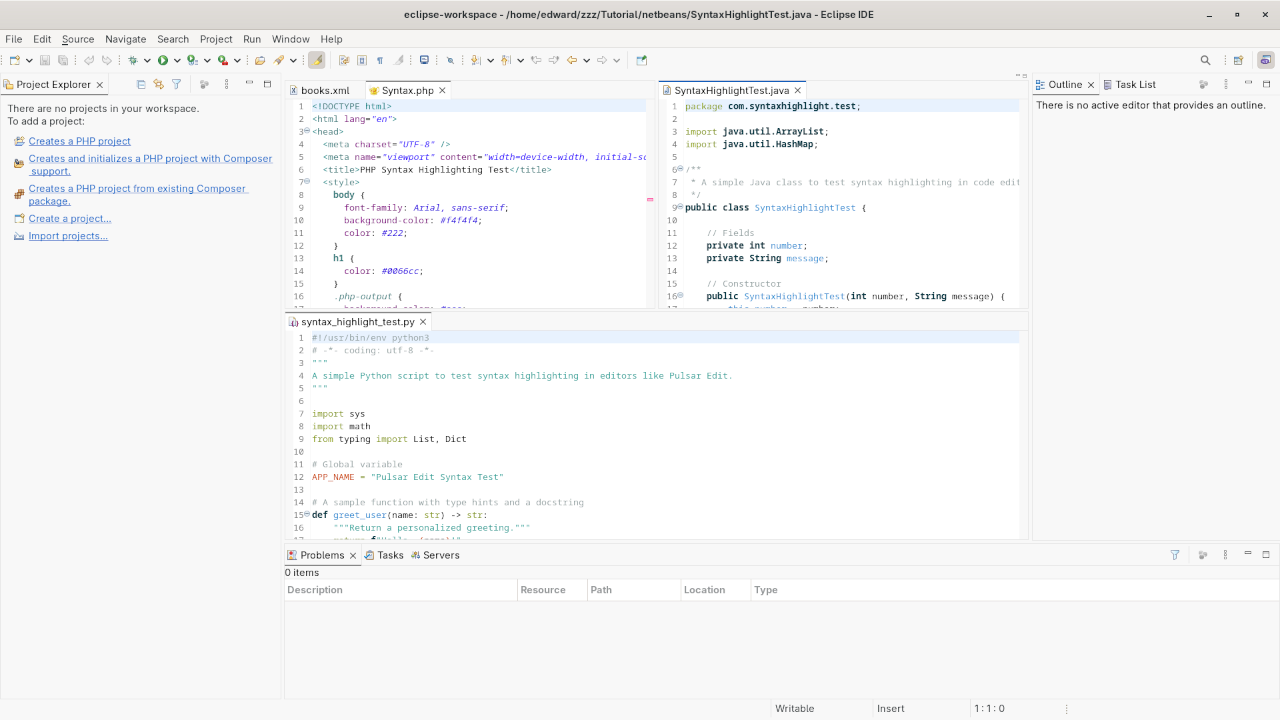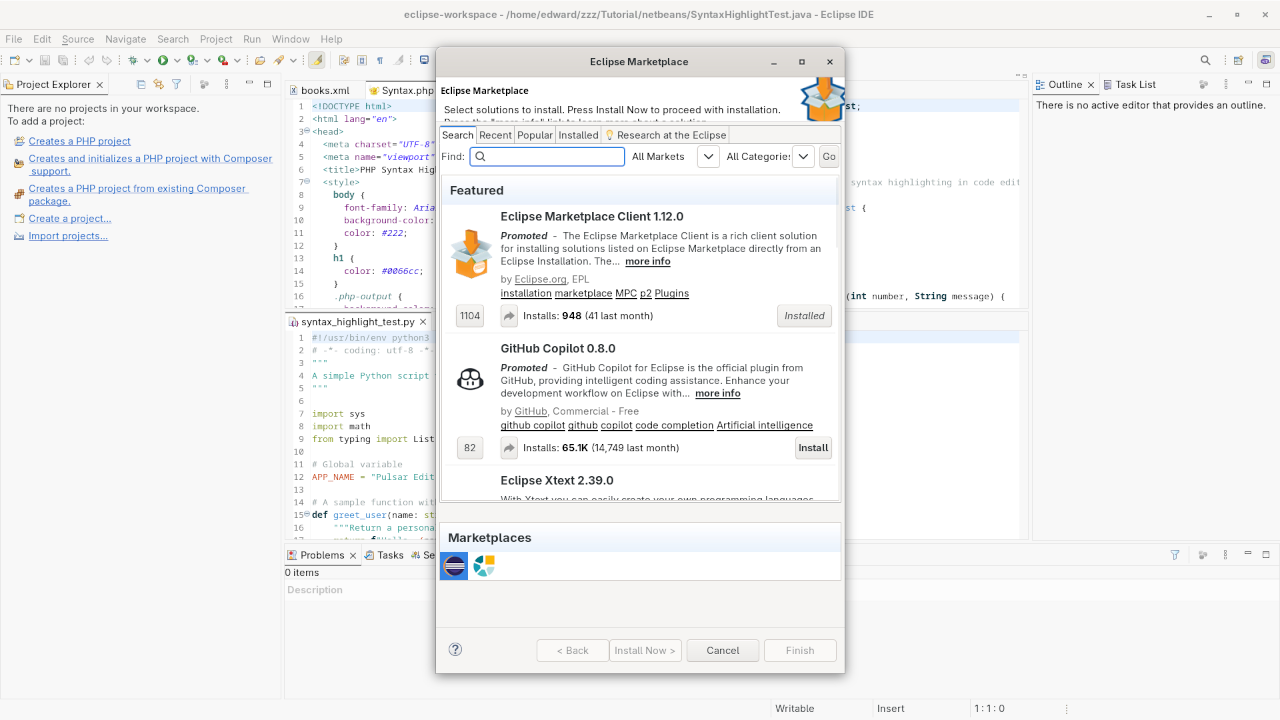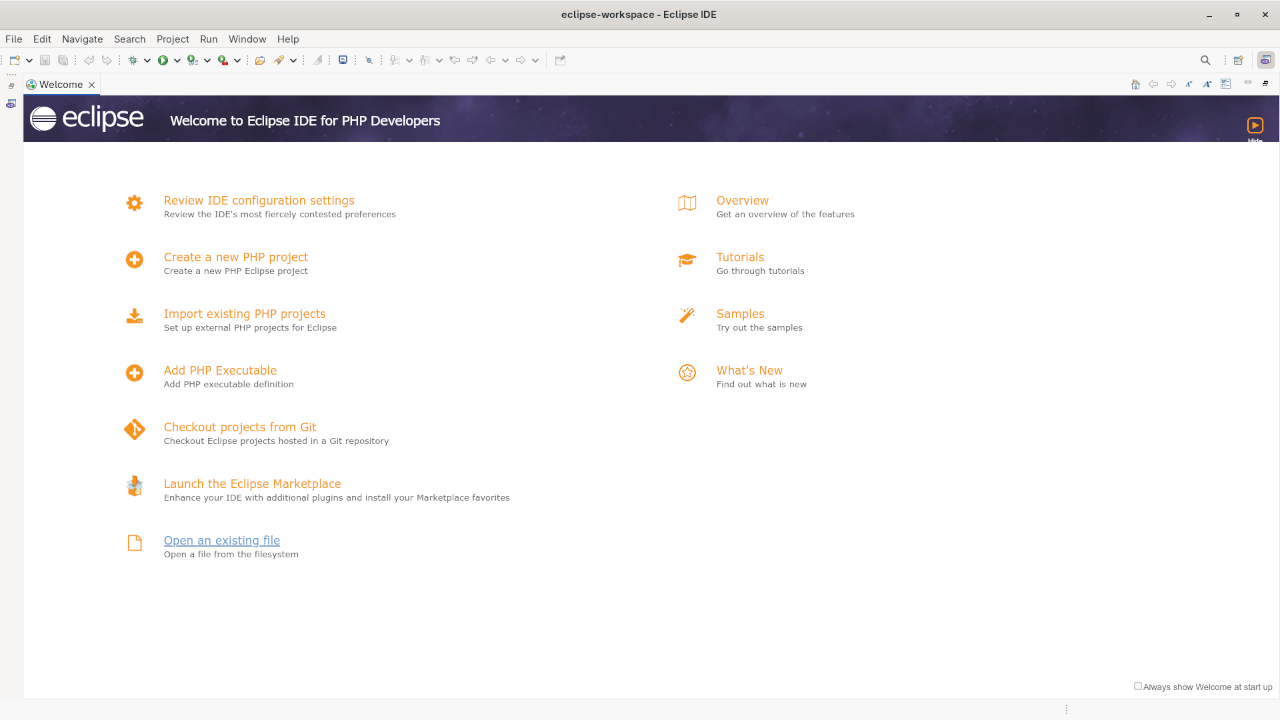Eclipse is a widely-used, open-source integrated development environment (IDE) that is flexible and can support multiple programming languages like HTML5, JavaScript, CSS3, PHP, and Python. While Eclipse is often associated with Java development, it can easily be adapted to web development through plugins and downloads.
In this guide, we’ll show you how to download and install the Eclipse IDE for PHP from the official Eclipse website, specifically for Fedora Linux. We will walk through the installation steps and provide tips on using Eclipse to develop web applications using HTML5, JavaScript, CSS3, PHP, and Python.
Additionally, I’ll mention some resources, such as my book Learning JavaScript and my course Learning JavaScript, that can help you deepen your web development skills.
Why Choose Eclipse for Web Development?
Eclipse is a great IDE choice for web developers for several reasons:
- Cross-Platform: Eclipse works on Linux, Windows, and macOS, making it an excellent tool for developers on different platforms.
- Open Source: Eclipse is completely free and open-source, allowing you to modify and extend the IDE based on your needs.
- Plugin Ecosystem: Through plugins, Eclipse can be customized for different languages, including HTML5, JavaScript, CSS3, PHP, and Python.
- Advanced Features: Eclipse comes with features like code completion, debugging tools, and integrated version control, which can enhance your coding experience.
Step-by-Step Guide: Installing Eclipse for PHP on Fedora Linux
The following steps will guide you through downloading and installing Eclipse IDE for PHP on Fedora Linux.
Step 1: Download Eclipse IDE for PHP
Eclipse provides a dedicated package for PHP development, which includes the necessary tools and plugins for building PHP applications.
1. Go to the official Eclipse website: Eclipse Downloads
2. Choose “Eclipse IDE for PHP Developers”: This package comes preconfigured with the required PHP development tools (PDT). Download the Linux version that matches your system architecture (64-bit or 32-bit).
3. Download the .tar.gz file and save it to your system.
Step 2: Extract and Install Eclipse
After downloading the Eclipse archive, extract it and set it up on your Fedora system.
- Open a terminal and navigate to the directory where you downloaded the Eclipse archive. For example:
cd ~/Downloads - Extract the downloaded .tar.gz file:
/tar -zxvf eclipse-inst-linux64.tar.gz - Move the extracted folder to a directory where you want to store Eclipse (e.g., /opt for system-wide access):
sudo mv eclipse /opt/
Step 3: Create a Desktop Shortcut (Optional)
You can create a desktop shortcut for easier access to Eclipse.
- Create a new .desktop file:
sudo nano /usr/share/applications/eclipse.desktop - Add the following content to the file:
[Desktop Entry] Name=Eclipse IDE for PHP Developers Comment=Eclipse IDE for PHP Development Exec=/opt/eclipse/eclipse Icon=/opt/eclipse/icon.xpm Terminal=false Type=Application Categories=Development;IDE; - Save and close the file (CTRL + X > Y > Enter).
Step 4: Launch Eclipse
Now that Eclipse is installed, you can run it by either:
- Launching it from the applications menu, or
- Running it from the terminal:
/opt/eclipse/eclipse
Step 5: Install PHP Development Tools (PDT)
Once Eclipse is launched, you will need to install the PHP Development Tools (PDT) plugin to enable PHP-specific features like syntax highlighting, code completion, and debugging.
- Go to Help > Eclipse Marketplace.
- In the Eclipse Marketplace, search for PHP Development Tools (PDT).
- Click Install to add the plugin to your Eclipse IDE.
After installation, restart Eclipse.
Step 6: Install Plugins for HTML5, JavaScript, CSS3, and Python
In addition to PHP, you can configure Eclipse to support HTML5, JavaScript, CSS3, and Python.
- Install Web Development Tools (for HTML5, JavaScript, and CSS3):
- Go to Help > Eclipse Marketplace.
- Search for Web Developer Tools and install the Eclim Web Developer Tools plugin.
- Install Python Tools:
- Go to Help > Eclipse Marketplace.
- Search for PyDev and install it for Python support.
After installing the necessary plugins, restart Eclipse.
Step 7: Start Your Web Development Project
With Eclipse set up and configured, you can now start your web development projects. You can create new projects for HTML5, JavaScript, CSS3, PHP, or Python by going to File > New and selecting the appropriate project type.


Requirements For Programming Text Editor
Glossary:
Code Editor
Designed for writing and editing source code.
IDE
Integrated Development Environment combines various tools need for software development.
Plugin
Software component that adds specific functionality.
Theme
Preset package containing graphical appearance to customize look and feel.
Open source
Freely available for possible modification and redistribution.
SCM
Source code management use to manage and track modifications to a source code repository.
LMB
Left Mouse Button (LMB) or left click
Test Tools
| Name | Description |
|---|---|
| CPU | Intel(R) i7 2600 @ 3.40GHz. |
| Memory | 16GB DDR3. |
| Operating System | Fedora Linux Workstation 42. |
| Desktop Environment | Gnome 48. |
| Name | Description |
| Name | Description |
|---|---|
| Large File | 1GB human-readable text. |
| Regex File | Text with word “Eclipse IDE” repeated. |
| Syntax File | PHP file containing HTML, CSS & JavaScript. |
| Media File | Smiley face or Tux Linux JPEG file. |
| Java Version | OpenJDK 21.0.7. |
| PHP Version | PHP 8.4.8. |
| Python Version | Python 3.13.3. |
| Eclipse IDE Version | 2.0. |
| Name | Description |
Test Scoring
- Each feature has two parts.
- Score of zero indicates a missing feature.
- A part of a feature is work a score of 0.5.
Three bias elimination steps were utilized. The editor was used for at least three years on different platforms. Attempts were made to get stable plug-ins for missing features. The same editor was compared between the one in the repository, the developers website, and the compiled version if applicable.
Selecting Editor Version
For this review, Eclipse IDE was downloaded from the developers website and it did not require additional plugins.
Features
- The theme can be native for the editor in terms of the background. Eclipse IDE dark and light themes can be created or downloaded. The score for the theme was a perfect 1.0.
- Dragging and dropping a text file into the editor opens a new tab. It is possible to specify the tab location during the drag and drop operation. The score for drag and drop into editor was 1.0.
- Opening a very large text file did not crash Eclipse IDE. A “Eclipse IDE” Warning window is shown with an option to continue. It remembers the last session and it was possible to edit the large file. The score for opening a large file was 1.0.
- Multiple documents can opened in multiple tabs. Tear-off tabs still do not work and Eclipse IDE does not have a feature to open in new window as a new instance which is handy for multiple monitors. The score for multiple documents was 0.5.
- Multiple editors can be opened as new tabs with drag options. The window view can be split either vertically or horizontally. The score for multiple editor view was 1.0.
- Creating non-project files is possible by using the built-in file explorer into the workspace. Non-project files cannot be opened by the drag and drop operation. The score for creating non-project files was a perfect 0.5.
- Soft word wrap can be enabled in the editor settings. Automatic soft wrap for documents is available for Eclipse IDE. The score for word wrap was a perfect 1.0.
- Spell check works as words are typed. Spelling errors are shown in opened documents. The score for spell check was a perfect 1.0.
- Word count is available for Eclipse IDE via a plugin. Selection word count is not available as part of word count. The score for word count was 0.5.
- Go to line
CTRL/CMD-Lcan jump to a specified line. It is possible to jump to either the first or last line. The score for go to line was a perfect 1.0. - Indentation can default to user-defined tab stops. Children are automatically indented. The score for indentation was a perfect 1.0
- Fonts can be dynamically scaled. The system font can be bypassed and a new editor font and size can be set. The score for fonts was a perfect 1.0.
- Find and replace
CTRL/CMD-For project-wideCTRL/CMD-SHIFT-Fusing regular expressions can be utilized for all open documents in the current session. Find and replace will work for the current document or a selection in the current document. The score for find and replacing using regular expressions was 1.0. - Multiple language syntax highlighting in one file is enabled if the language plug-ins are installed. Each language has code-sensitive syntax colors which can be modified. The score for multiple language syntax highlighting was a perfect 1.0.
- Code folding works for markup languages such as HTML. Code folding also works for programming languages such as Java and PHP. The score for code folding was 1.0.
- Selecting rectangular block per column
SHIFT/ALT-Aworks. Rectangular block selections works with word wrap enabled. The score for selecting rectangular block was a perfect 1.0. - Multiple selection
ALT/CMD-LMBis available for Eclipse IDE. Search multiple selection is available. The score for multiple selection was 1.0. - Distraction-free mode to hide panes works. Line numbers can be toggled in the settings to improve distraction-free mode. The score for distraction-free was a perfect 1.0.
- The file manager can create and delete folders. Media files can be dragged and dropped into the file manager pane. The score for file manager was 1.0.
- Terminal is not integrated into Eclipse IDE, but one can be enabled as a plugin. The terminal can follow folder if enabled. Terminal can execute system commands. The score for terminal was 1.0.
Results
Eclipse IDE is a very powerful IDE. By default, the Eclipse IDE editor worked without tweaks, and any missing required features can be installed by using plugins. For my required features, the Eclipse IDE editor scored 92.50% or 9.25 out of 10.
Additional Resources to Help You Learn JavaScript
If you’re focusing on JavaScript, check out my book Learning JavaScript. It’s designed specifically for beginners, covering essential JavaScript concepts and providing practical examples that will help you start writing JavaScript code quickly.
Additionally, if you prefer guided tutorials, my JavaScript course can help you get a deeper understanding of the language through structured lessons and projects.
Need One-on-One Programming Help?
If you need one-on-one support for setting up Eclipse, understanding PHP, JavaScript, or any other programming concept, I offer personalized programming tutorials. Whether it’s getting Eclipse configured or learning how to write cleaner, more efficient code, I’m available to help!
Visit my contact page to get started.
Disclosure: Some of the links above are referral (affiliate) links. I may earn a commission if you purchase through them - at no extra cost to you.
